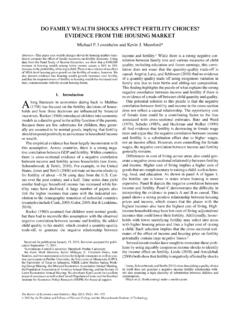Transcription of OECD Family Database …
1 OECD Family Database OECD - Social policy division - directorate of employment , labour and Social Affairs Updated: 12-06-2018 1 : Fertility rates Definitions and methodology This indicator presents information on levels and trends in fertility rates and the distribution of births by birth order. Fertility rates are captured through two measures: The Total Fertility Rate (TFR), or the average number of children born per woman over a lifetime given current age-specific fertility rates and assuming no female mortality during reproductive years. TFRs are computed as the sum of age-specific fertility rates defined over five-year intervals.
2 Data on the TFR come mostly from national statistical offices and other international organisations ( Eurostat and the World Bank). Assuming no migration and that mortality rates remain unchanged, a TFR of children per woman is generally sufficient to generate a stable population within a given country. A TFR above or below this population replacement rate is likely to produce population growth and population decline, respectively. Completed Cohort Fertility (CCF), or the average number of children born to women belonging to certain cohort over the whole of their reproductive lives. Data on completed cohort fertility come from the Human Fertility Database (HFD), which calculates completed cohort fertility for a given cohort if data are available for that cohort at age 44 or above and by using data for the highest available age up to age 50.
3 The distribution of births by birth order is measured through the distribution of births by the rank of the birth from the perspective of the biological mother. Three rank groups are used here first births, second births, and third or higher births. Key Findings Across almost all of the OECD, current fertility rates are well below those needed for population replacement (Chart ). In most OECD countries TFRs sit somewhere between and children per woman, with rates falling as low as in Italy and Spain, and in Korea. Only three OECD countries (Israel, Mexico and Turkey) have a current TFR at or above the children per woman needed for population replacement.
4 At , Israel has the highest TFR in the OECD. Below-replacement-rate levels of fertility are not new. Chart shows that while in 1970 many OECD countries had TFRs around or above , by 1995 most had rates well below replacement level. Indeed, in many OECD countries TFRs have actually increased slightly since 1995 in Germany, for example, the total fertility rate is about points higher now than it was in 1995. Nonetheless, in most cases any increases are relatively small and are far from what is required in order to raise fertility to the children per woman needed for a stable population. Data on completed fertility paint a largely similar picture.
5 Chart shows CCF for women born in 1950, in 1960, and in 1970. For all three birth cohorts, completed fertility is in most countries well below the children per woman needed for population replacement. For the 1950 cohort, only the Czech Republic, France, Iceland, the Slovak Republic and Spain have CCF levels above For the 1970 cohort, this group falls to just Iceland alone. CCF also appears to be falling over time only Finland and the United States see CCF increase between the 1950 cohort and the 1970 cohort, with all other countries seeing completed fertility fall between women born in 1950 and those born in 1970. The decreases in Japan ( children per woman) and Spain ( children per woman) are particularly large.
6 Other relevant indicators: Family size and composition ( ); Age of mothers at childbirth ( ); Share of births outside marriage ( ); Childlessness ( ); and, Marriage and divorce rates ( ). OECD Family Database OECD - Social policy division - directorate of employment , labour and Social Affairs Updated: 12-06-2018 2 Chart Total fertility rate, 1970, 1995 and 2016 or latest availablea Average number of children born per woman over a lifetime given current age-specific fertility rates and assuming no female mortality during reproductive years a) Data for Chile refer to 2015 b) The statistical data for Israel are supplied by and under the responsibility of the relevant Israeli authorities.
7 The use of such data by the OECD is without prejudice to the status of the Golan Heights, East Jerusalem and Israeli settlements in the West Bank under the terms of international law. c) Footnote by Turkey: The information in this document with reference to Cyprus relates to the southern part of the Island. There is no single authority representing both Turkish and Greek Cypriot people on the Island. Turkey recognizes the Turkish Republic of Northern Cyprus (TRNC). Until a lasting and equitable solution is found within the context of United Nations, Turkey shall preserve its position concerning the Cyprus issue ; d) Footnote by all the European Union Member States of the OECD and the European Commission: The Republic of Cyprus is recognized by all members of the United Nations with the exception of Turkey.
8 The information in this document relates to the area under the effective control of the Government of the Republic of Cyprus. Sources: for Argentina, Brazil, China, Colombia, Costa Rica, India, Indonesia, Peru, the Russian Federation, Saudi Arabia and South Africa, World Bank World Development Indicators; for Australia, Australia Bureau of Statistics; for Austria, Statistics Austria; for Belgium, Bureau f d ral du Plan; for Bulgaria, Croatia, Cyprus, Greece, Latvia, Lithuania, Luxembourg, Malta, Romania, the Slovak Republic, Switzerland and the United Kingdom, Eurostat Population Statistics; for Canada, Statistics Canada; for Chile, Instituto Nacional de Estad sticas; for the Czech Republic, Czech Statistical Office.
9 For Denmark, Statistics Denmark; for Estonia, Statistics Estonia; for Finland, Statistics Finland; for France, INSEE; for Germany, Destatis; for Hungary, Hungarian Central Statistical Office; for Iceland, Statistics Iceland; for Ireland, Irish Central Statistics Office; for Israel, Central Bureau of Statistics; for Italy, ISTAT; for Japan, Ministry of Health and Welfare; for Korea, KOSIS; for Mexico, Consejo Nacional de Poblaci n; for the Netherlands, Statistics Netherlands; for New Zealand, Statistics New Zealand; for Norway, Statistics Norway; for Poland, Polish Central Statistical Office; for Portugal, INE; for the Russian Federation, Institute of Demography at the National Research University 'Higher School of Economics'; for Slovenia, Statistical Office of the Republic of Slovenia; for Spain, INE; for Sweden, Statistics Sweden; for Turkey, TurkStat.
10 For the United States, Department of Health and Human Services Chart Completed cohort fertility a for women born in 1950, 1960 and 1970 (or latest available) b 1 0123456 Children per woman 201619951970 Population replacement per woman Women born in 1950 Women born in 1960 Women born in 1970 OECD Family Database OECD - Social policy division - directorate of employment , labour and Social Affairs Updated: 12-06-2018 3 a) Completed cohort fertility is defined as the average number of children born to women belonging to certain cohort over the whole of their reproductive lives. The Human Fertility Database calculates completed cohort fertility for a given cohort if data are available for that cohort at age 44 or above, and by using data for the highest available age up to age 50.















